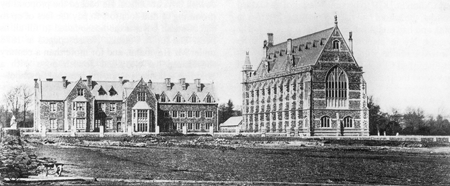 |
 |
The Council recalled Hansom in the 1870’s to add the Percival Library range with its open-cloister classrooms. This was built in two stages and completed by 1875 – though the Wilson Tower was not added until 1890. So the South Quad was left open to the Close on its southern side, and present Cliftonians can be grateful that shortage of money in the 1860’s had allowed time for second thoughts.
 By 1875 Brown’s House and the future Dakyns’ and Oakley’s had been opened; what is now 32 College Road (the school's Office) had been built as accommodation for bachelor masters. Also, three fives courts (1864), the sanatorium (1865), the gymnasium (1867), two swimming baths (1869), an open rackets court (1872) and the present workshop (1873) had all been added. But most important of all was the opening of the Chapel in 1867. Built to Charles Hansom’s original design, but moved from its intended site (now occupied by the gymnasium), the Chapel was a narrow aisle-less building, the width of its present west end.
By 1875 Brown’s House and the future Dakyns’ and Oakley’s had been opened; what is now 32 College Road (the school's Office) had been built as accommodation for bachelor masters. Also, three fives courts (1864), the sanatorium (1865), the gymnasium (1867), two swimming baths (1869), an open rackets court (1872) and the present workshop (1873) had all been added. But most important of all was the opening of the Chapel in 1867. Built to Charles Hansom’s original design, but moved from its intended site (now occupied by the gymnasium), the Chapel was a narrow aisle-less building, the width of its present west end.
The Chapel was the gift of Mrs Guthrie, widow of Canon Guthrie, the first Chairman of the College Council. The architect was given permission “to quarry sufficient stone from the College grounds for the purposes of the Chapel building”. Mrs Guthrie died before work was completed, but she is remembered each year at Commemoration (first held 1968), when the school gives thanks for the generosity of “John Guthrie and Caroline his wife, founders of this Chapel, for John Percival, first Headmaster, and for all our Governors and benefactors, by whose benefit this whole School is brought up to godliness and good learning.”
The Chapel was licensed by the Bishop of Gloucester and Bristol on Saturday, 15th June, 1867, and the preacher the next day was Frederick Temple, still Headmaster of Rugby, but destined to be Archbishop of Canterbury. He preached on the parable of the sower, and told the boys that they would have grown up differently “if there had been no such building here, no such services, no such regularity of religious observance.”
The College Council was no doubt grateful to Temple, who had recommended Percival to them. John Percival may have been second choice, but never has second-best been a better buy! Before he left Clifton in 1879 to become Master of an Oxford college, the school had risen in numbers from 76 to 600, and had established a national reputation. His success lay in blending the best features of the Arnold tradition, with a liberal radicalism that has distinguished Clifton from other public schools and has stood the test of time.
Clifton's Later Buildings >>
